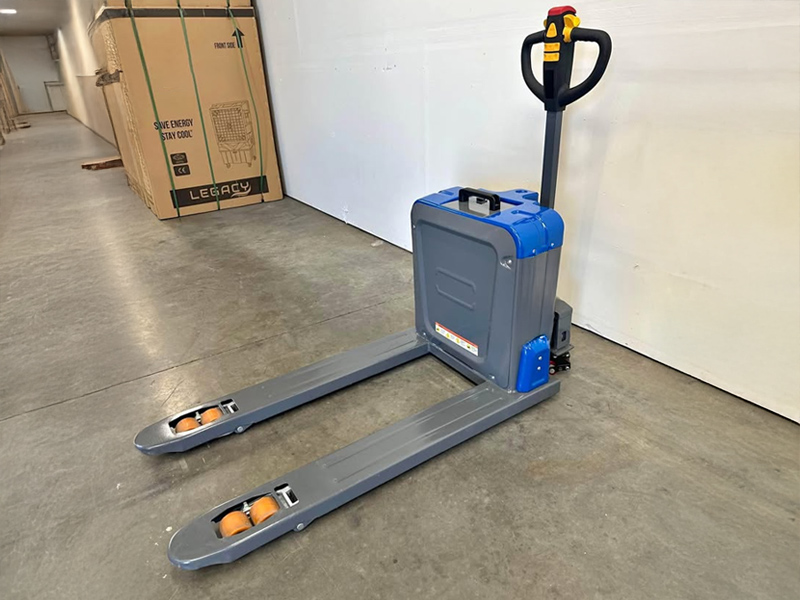Selecting the correct wheels for your pallet jack isn’t just a matter of finding a replacement that fits; it’s a critical decision that impacts your equipment’s performance, the longevity of your facility’s floors, and the efficiency and safety of your entire material handling operation. The right wheels ensure smooth movement, minimize downtime, and reduce strain on both the operator and the jack itself.
To make an informed choice, you must systematically evaluate the core factors of your operating environment, load requirements, and desired performance characteristics.
Step 1: Assess Your Environment and Floors
The most crucial factor when choosing pallet jack wheels is the surface the pallet jack will be traveling over. The wrong material can quickly fail, damage expensive flooring, or make the jack nearly impossible to push.
1. Flooring Material and Condition
- Smooth, Delicate, or Finished Floors (Epoxy, Tile, Polished Concrete): These floors require wheels that are soft, non-marking, and offer excellent shock absorption. Polyurethane (PU) is the industry standard here, offering great floor protection and quiet operation without sacrificing too much capacity. Rubber is the softest, offering maximum protection and quietest movement, ideal for very sensitive or retail floors, though at a lower load capacity.
- Rough, Old, or Damaged Concrete/Asphalt: These surfaces require a wheel that can withstand abuse, debris, and cracks without chunking or puncturing. Nylon (Polyamide) is excellent for its extreme hardness and durability. Vulkollan®, a premium polyurethane, also performs exceptionally well due to its superior elasticity and resistance to cutting and tearing.
- Floors with Gaps, Seams, or Dock Plates: Tandem (double) load wheels are essential here, as they distribute the weight over four points instead of two, bridging gaps and preventing the wheels from getting stuck.
2. Exposure to Moisture and Chemicals
In environments like freezers, meat processing plants, chemical storage, or wash-down areas, material resistance is key.
- Nylon is highly resistant to water, most acids, bases, and solvents. It will not swell, rust, or degrade from continuous moisture exposure, making it the preferred choice for corrosive and wet environments.
- Cast Iron is highly susceptible to rust and is generally unsuitable for wet environments unless coated or paired with specialized bearings.
3. Temperature Extremes
- Freezers/Cold Storage: Materials can become brittle at sub-zero temperatures. High-grade Nylon and specialized polyurethane compounds are necessary to maintain elasticity and prevent cracking.
- High-Heat Areas (e.g., Near Ovens or Furnaces): Standard PU will soften and break down. Cast iron or phenolic wheels, designed to withstand high operating temperatures, are required.
Step 2: Evaluate Load, Capacity, and Performance
The structural integrity and long-term performance of your wheels depend on managing the load and operational goals.
1. Load Capacity
Always ensure the wheel’s combined dynamic load rating meets or exceeds the maximum weight your pallet jack will handle.
- Heavy Loads: Cast Iron and Nylon wheels offer the highest capacity.
- Standard Loads (up to 5,500 lbs): High-quality Polyurethane is typically sufficient and offers the best compromise between capacity and floor protection.
2. Noise Level
If your operation is near offices, retail floors, or within residential areas where noise pollution is a concern, prioritize softer materials.
- Rubber and Polyurethane are significantly quieter than the loud, jarring noise produced by hard Nylon or Cast Iron wheels on concrete.
3. Required Service Life and Maintenance
While a wheel’s initial cost is a factor, its total cost of ownership is more important.
- Nylon and Cast Iron are extremely long-lasting in their preferred environments, resulting in less frequent replacement.
- Polyurethane offers an excellent lifespan for general warehousing, provided it is a high-quality blend and not a cheap, low-density alternative that will chunk or de-bond quickly.
Step 3: Understand Wheel Configuration and Sizing
Wheel dimensions are non-negotiable—you must replace a wheel with one of the exact same diameter, width, and hub length to ensure proper fit and safe operation.
1. Load Wheels vs. Steering Wheels
Pallet jacks have two distinct sets of wheels:
- Load Wheels (Fork Wheels): The smaller wheels located at the tip of the forks. They carry the vast majority of the load. They are the most common point of failure and require the highest durability.
- Steering Wheels: The larger wheels connected to the handle. They are crucial for grip and smooth direction changes.
2. Single vs. Tandem Load Wheels
- Single Wheels (One wheel per fork): Better maneuverability in extremely tight spaces and on perfectly flat, clean floors.
- Tandem Wheels (Two wheels per fork): Highly recommended for general-purpose use. They distribute the load, minimize floor contact pressure, and easily roll over floor joints, debris, and dock plates, significantly reducing operator effort and wheel damage.
Conclusion: The Optimal Combination
For the majority of standard, high-volume warehouse applications, a combined approach often yields the best results:
- Tandem Polyurethane Load Wheels: Provides the necessary capacity and durability while protecting your floors.
- Polyurethane or Rubber Steering Wheels: Ensures smooth steering, excellent grip, and quiet operation.
Before making a final purchase, always verify the exact dimensions of your existing pallet wheels and consider consulting your pallet jack’s manufacturer or a specialty material handling supplier. Choosing the right wheel is a small investment that pays large dividends in operational efficiency and facility maintenance.






